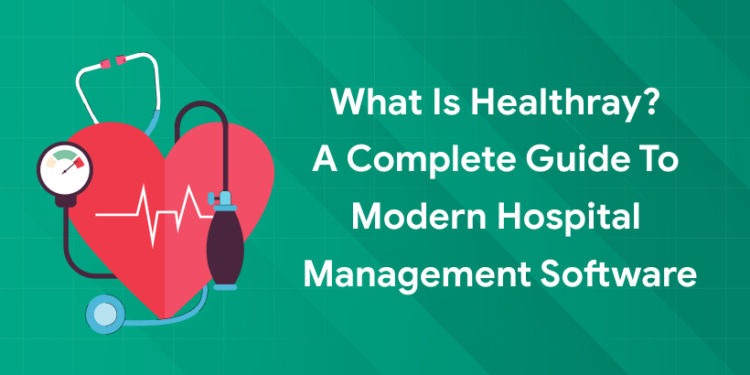Table of Contents
Key Takeaways:
- Healthray is an AI-driven hospital management system trusted by 1,000+ hospitals globally.
- It offers cloud-based automation across all hospital departments—OPD, IPD, pharmacy, finance, and HR.
- Features include AI-backed analytics, EHR integration, and data security compliant with NABH, ABDM, and HIPAA.
- The platform improves hospital efficiency, patient care, and decision-making.
- Professionals can advance their careers through Entri’s Hospital Administration Course, with placement support and training in modern healthcare systems.
Introduction: Digitizing the Heart of Healthcare
Hospital corridors often echo with the hum of medical urgency—patients waiting, staff rushing, and administrators scrambling to balance endless tasks. Traditional hospital systems often drown in paperwork, delayed coordination, and manual mistakes. Amid this growing complexity, healthcare facilities increasingly rely on AI-powered, integrated management systems to streamline operations.
Meet Healthray, the all-in-one AI-driven Hospital Management Software (HMS) redefining global healthcare standards. More than a tool—it’s an ecosystem that connects departments, automates workflows, and empowers decision-making, allowing medical professionals to focus on what truly matters: patient care.
What Is Healthray?
1: What is the primary role of a hospital administrator?
Healthray is an AI-powered, cloud-based Hospital Management System (HMS) that centralizes hospital data and automates day-to-day operations. Designed for hospitals, clinics, and diagnostic centers, it integrates everything—from patient registration to discharge—under one seamless interface. It’s not just software; it’s a digital infrastructure crafted to enhance efficiency, increase revenue, and elevate the entire patient experience.
At its core, Healthray transforms traditional health management into a data-smart ecosystem. Instead of juggling multiple platforms, administrators and clinicians can now manage appointments, financials, inventory, reports, and employee data within a single interface.
How Healthray Works
- Centralized Cloud System: All records—patient histories, lab reports, and billing details—are stored securely on a cloud server. This ensures doctors and staff can access data remotely without delays.
- AI Support: Smart algorithms predict patient needs, automate prescriptions, and even detect irregularities in data entries. This assists in precise diagnostics and faster decision-making.
- Modular Design: Healthray is built with flexible modules such as EMR, OPD/IPD, pharmacy, lab, HR, and finance—all of which can be scaled according to a hospital’s size and requirement.
- Automated Workflow: Every detail, from admissions to inventory updates, flows in real time between departments, ensuring no information gap.
Distinctive Advantages
- Unified Healthcare Operations: A single dashboard to manage OPD schedules, OT operations, ICU monitoring, and ambulance management.
- Security & Compliance: Incorporates encryption, user role-based access, and full compliance with NABH, ABDM, and HIPAA standards.
- Accurate Data Analytics: Hospitals get insights on patient trends, revenue, and performance metrics through automated reports.
- Seamless EMR Integration: Medical professionals can update, retrieve, and share patient records without manual delays or paper trails.
- Cost Savings: By minimizing repetitive administrative tasks, hospitals save time, reduce workforce burden, and cut operational costs up to 25%.
Ultimately, Healthray represents the shift from reactive healthcare management to predictive, data-informed, and digitally empowered healthcare. It’s an all-in-one solution built for tomorrow’s medical challenges, today.
Hospital Administration Course with Assured Career Growth
Hospital Administration Course by Entri App: Master essential healthcare management skills, gain certification, and secure top roles in leading hospitals
Join Now!Core Modules and Their Functionalities
| Module | Purpose | Healthray Features | Key Benefits |
|---|---|---|---|
| OPD & IPD Management | Manage patient admissions and discharges | Smart patient registration, bed management, automated billing | Reduced waiting time and paperless workflow |
| Pharmacy Management | Oversee drug stock and sales | AI-based inventory tracking, integration with prescriptions | Prevents stockouts and automates reorders |
| Laboratory Information System (LIS) | Manage lab workflow | Automated report generation, integration with diagnostic tools | Faster result delivery and improved accuracy |
| Radiology Management | Handle imaging records | DICOM compatibility and image archiving | Real-time image access for diagnostics |
| Finance & Claims | Manage hospital finances | Automated invoice and claims tracking | Faster payments and reduced clerical errors |
| HR Management | Oversee staff operations | Shift tracking, payroll automation, attendance analytics | Improves staff productivity and accountability |
| EMR (Electronic Medical Records) | Store digital patient data | Centralized data entry with voice recognition | Informed diagnosis and data-driven decisions |
Key Features That Set Healthray Apart
1. End-to-End Digitalization
Healthray automates administrative tasks—from appointment scheduling to discharge summaries—making hospital operations 90% faster. It allows paper-free workflow management with customized dashboards for doctors, nurses, and administrators.
Hospital Administration Course with Assured Career Growth
Hospital Administration Course by Entri App: Master essential healthcare management skills, gain certification, and secure top roles in leading hospitals
Join Now!2. Healthcare Interoperability
With built-in FHIR and ICD-10/11 compliance, Healthray ensures smooth communication across multiple hospital networks. Whether it’s lab reports, prescription updates, or diagnostic images, every piece of data is synchronized securely and accurately.
3. AI-Enhanced Data Analytics
Healthray uses predictive insights to forecast resource usage, patient inflow, and revenue trends. Hospitals can use these analytics for smarter staffing, optimized costs, and preventive decision-making.
4. Security & Compliance
Every record within Healthray is HIPAA and NABH compliant, utilizing advanced encryption and controlled data access for maximum confidentiality.
5. Multi-Device Accessibility
Hospital staff can access dashboards via desktops, tablets, or mobile phones—making it extremely useful in multi-location networks and for on-call coordination.
How Healthray Is Transforming Hospital Efficiency
Healthray’s AI modules help hospitals reduce operational delays and human errors. For instance:
- 30% reduction in patient waiting times due to automated queue management.
- 40% faster insurance claims processing and payment cycles.
- 25% improvement in hospital revenue through predictive financial analysis. [1]
This transformation directly improves patient experience, reduces staff burnout, and establishes an ecosystem of informed clinical care.
Also read: EMR vs EHR vs HMS: What’s the Difference?
Real-World Example
Universal Hospitals reported that after integrating Healthray:
- Patient satisfaction is at 92%,
- Wait time was reduced by 45%,
- And cost reduction of 30% was observed. [2]
Such use cases highlight Healthray’s adaptability for both small clinics and regional hospital networks.
Tips for Implementing Healthray in Your Hospital
Transitioning from manual healthcare workflows to automated systems can feel daunting, but Healthray simplifies the process with its deployed training support and user-friendly modules. Here’s how hospitals can make the implementation smooth and effective:
1. Start with Core Functionalities
Begin with primary modules such as patient registration, billing, and inventory, then expand toward specialized modules like radiology or HR management. Gradual adoption helps staff get comfortable while maintaining service continuity.
2. Train Your Team Thoroughly
Technology becomes powerful when users fully understand it. Invest in training sessions for doctors, receptionists, and nurses. Healthray provides demo dashboards and support materials to make onboarding faster and simpler.
3. Create a Data Migration Strategy
If shifting from older systems, ensure patient databases, billing records, and medical histories are safely migrated to Healthray’s cloud platform. Use Healthray’s data integration services for accurate, secure transitions.
4. Utilize Real-Time Analytics
Hospitals can use Healthray’s analytics dashboard to track patient wait times, occupancy rates, and financial performance. Regular reviews help improve efficiency and forecast resource requirements effectively.
5. Leverage Cloud Access for Remote Collaboration
Enable authorized staff to use mobile and remote logins. This empowers doctors to access reports from anywhere—ideal for teleconsultations or emergency reviews.
6. Prioritize Patient Awareness
Communicate with patients about the new system. Encourage them to use digital patient portals for report downloads, appointment bookings, and bill payments. A well-informed patient base accelerates adoption and enhances satisfaction.
7. Measure Outcomes Post-Implementation
After the rollout, compare operational KPIs such as billing accuracy, patient turnaround time, and claim settlements with pre-digital metrics. Use these insights to refine processes further.
When implemented strategically, Healthray doesn’t just transform efficiency—it reshapes hospital culture into a tech-enabled, patient-first environment.
Building a Career in Hospital Administration
If technology inspires you and healthcare fascinates you, becoming a hospital administrator could be your next big step. Handling tools like Healthray requires a strong understanding of hospital operations, compliance, and digital systems.
That’s where Entri’s Hospital Administration Course plays a crucial role. This course offers:
- Comprehensive modules on hospital operations, finance, and HR systems
- Simulated training with AI-enhanced HMS tools
- Placement support with leading hospitals and healthcare companies in India
- Industry-recognized certification to boost your career prospects
Conclusion: Transform Healthcare with Knowledge and Innovation
Healthcare is evolving, and technology is its driving force. Platforms like Healthray demonstrate how automation and AI can revolutionize hospital administration, improve patient care, and reduce costs.
As hospitals go digital, skilled administrators become central to this transformation. If you dream of managing next-generation facilities and want to build expertise in tools like Healthray, start your journey today with Entri’s Hospital Administration Course—your gateway to a smarter, digitally aligned healthcare career.
| Also Read | |
| How to Become a Hospital Administrator | |
| Top Skills Needed for a Successful Career in Hospital Administration | |
| Career Pathways in Hospital and Healthcare Administration |
Hospital Administration Course with Assured Career Growth
Hospital Administration Course by Entri App: Master essential healthcare management skills, gain certification, and secure top roles in leading hospitals
Join Now!Frequently Asked Questions
Is Healthray customizable for different hospital sizes?
Yes, Healthray can be scaled for small clinics to large healthcare institutions.
Does it support real-time patient tracking?
Absolutely. Its cloud system synchronizes appointments, diagnostics, and billing in real time.
How does it ensure data security?
Healthray deploys encrypted cloud storage compliant with HIPAA and GDPR standards.
Is AI integration beneficial for cost control?
Yes. Predictive insights optimize staff allocation, stock usage, and energy expenses.
What qualification helps manage systems like Healthray?
A formal certification—like the Entri Hospital Administration Course—equips candidates with hands-on experience and employability in tech-enabled healthcare management.















